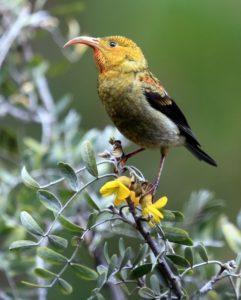‘I’iwi Making Appearance in Lower Elevations
The endangered ‘I’iwi, also known as the scarlet honeycreeper, have been making a rare appearance in residential areas Upcountry.
The threatened bird species are mostly seen around Hosmer Grove in Haleakalā National Park and the Kula Forest Reserve.
“Though the birds are in high-elevation habitat that’s fairly inaccessible to people, they do occasionally come down the mountain,” said Dr. Hanna Mounce, manager of the Maui Forest Bird Recovery Project.
Following the introduction of mosquitoes to Hawai‘i many native birds, intolerant to mosquito borne diseases, died out in the lowland areas of the main islands. This left only high elevation forests (areas without disease transmission) suitable for native birds, separating the birds from people.
“Some native honeycreepers are developing resistance to these diseases and re-expanding their ranges downhill. We do not yet know if this is occurring in ‘I‘iwi,” Mounce says.
The ‘I‘iwi is only found in Hawai‘i and have scarlet plumage over much of their bodies, black and white wings, and a long, drooping, almost silly-looking bill.
These birds are sometimes confused with the common Northern Cardinal, introduced in 1929, which have a red body and tail, short red bill, and sport a crest on their heads.
Juvenile ‘I‘iwi are not red but start out with a cheetah-like spotted pattern and slowly gain red feathers in a patchy pattern until their whole bodies are eventually red. Often it’s the juveniles that move to lower elevations.
Conservation groups like Maui Forest Bird Recovery Project, The Nature Conservancy, East Maui Watershed Partnership and others work to protect the remaining habitat and restore degraded areas so these can once again be suitable for species like ‘I‘iwi.
‘I‘iwi were recently added to the US Endangered Species List due to severe declines across their range.
Local bird groups say an expansion into lower elevations could be a critical development and that many residents may have seen or heard ‘I’iwi without being aware of the significance of their sightings.
The groups say more frequent sightings can occur if homeowners do their part by planting native trees like flowering ʻōhiʻa and māmane, eliminate invasive species, and control pets and feral animal populations.
The group adds that sightings in West Maui, Molokaʻi and Lānaʻi are also notable, as very few ‘I‘iwi remain in these areas.
The local bird groups ask residents to report any ‘I‘iwi sightings on the Maui Forest Bird Recovery Project or Hawaiʻi Birdwatching Facebook page or eBird website.












